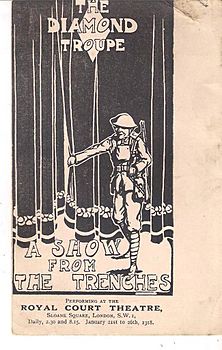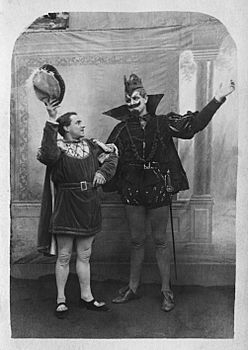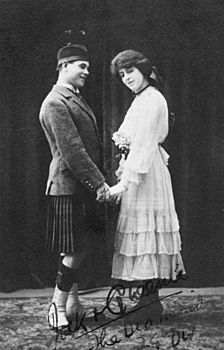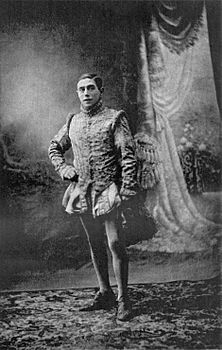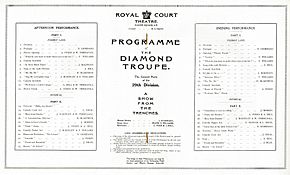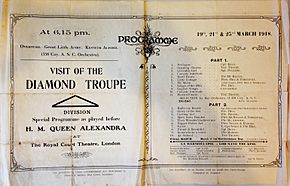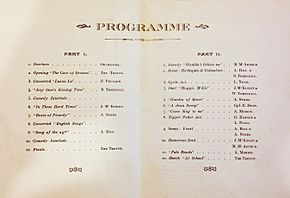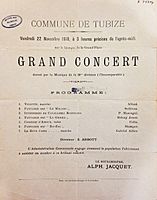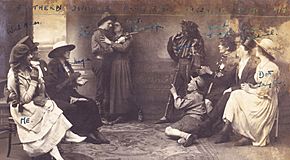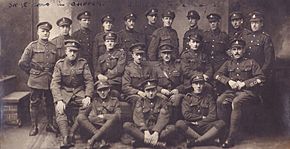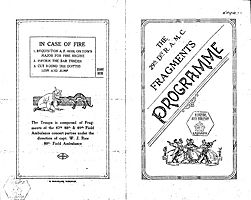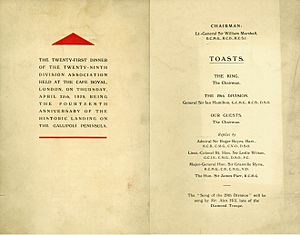The Diamond Troupe facts for kids
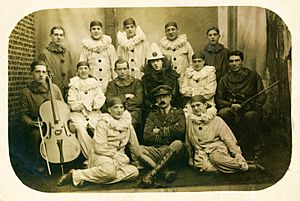
The Diamond Troupe, 1917. Front row (from left to right): Pte. Eric John Dean, Lt. Col. E. Trevor Wright, Pte. Lawrence Nicol. Middle row: Pte. Hubert Holmes (cellist), Corp. Frank Pollard, L/Corp. Robert James Stannard, Pte. William Threlfall, Pte. Arthur Sykes, Pte. H. Palmer (violinist). Back row: Pte. Neville Giordano, Pte. Jock McKinley, Pte. Alec Hill, Pte. George Hangle, Pte. J. Morris.
|
|
| Type | Theatre group |
|---|---|
| Purpose | Concert party |
| Location |
|
|
Membership
|
Musicians, singers, and actors from nine regiments within the 29th Division (United Kingdom) |
The Diamond Troupe was a special entertainment group. They performed for the 29th Division during World War I. This division was a famous part of the British Army. It was known as the "Incomparable Division."
The 29th Division was created in 1915. Its soldiers had served in different parts of the British Empire. They fought in the Gallipoli Campaign and later on the Western Front in France.
Concert parties were very important during the war. By 1917, almost every army division had one. These groups were like the popular Pierrot shows. They gave soldiers a break from the fighting. They reminded them of home and offered a way to relax.
The Diamond Troupe became very famous. They were known both on the battlefield and back home. Their success came from the division's fame. Also, many troupe members were amazing performers. The female impersonator was a huge hit. He was known as "the show-stopper."
Robert James Stannard, the music director, wrote in his diary. He said that Alec Hill's singing was a big hit. "Queenie," the female impersonator, fooled many people. Larry Nicol, the trick cyclist, was also very popular.
A historian named Jason Wilson praised the Diamond Troupe. He called them one of the "notable concert parties of the British Expeditionary Forces."
Contents
Forming the Diamond Troupe
The Diamond Troupe started in April 1917. This was in Arras, France. The 29th Division's main offices were there. The area had ruins and sounds of distant shelling.
This is where the first auditions happened. Sixty soldiers from the division tried out. Eight were chosen at first. Most members had performed before. All of them had served near the enemy lines. One member, Pte. Neville Giordano, had been part of the Gallipoli landing in 1915.
The name "Diamond Troupe" came from the 29th Division's logo. It was a red half-diamond. The name also came from the "diamond formation." This was a strong way for soldiers to advance in battle.
Meet the Members
Keeping a full cast was hard for all concert groups. Battalions moved often. Also, many soldiers were injured or killed. Members of the Diamond Troupe did not have to fight on the front lines. But the group's members did change over time.
Here are the people who were part of the troupe:
| Name | Regiment/Regimental Number | Date joined 29th Division |
|---|---|---|
| Pte. Neville George Romolus Giordano (1892–1958) | Royal Army Medical Corps, No. 2105 | March 1915 |
| L/Cp. Robert James Stannard (1891–1960) | Royal Fusiliers, No. 11481 | November 1915 |
| Pte. William Threlfall (1895–1940) | Royal Army Medical Corps, No. 2140 | February 1916 |
| Pte. Alec [Alexander] Hill (1894–1969) | Middlesex Regiment, No. PS/2213 | May 1916 |
| Pte. H. Palmer | Middlesex Regiment | May 1916 |
| Pte. Frank [Francis] Pollard | Inniskilling Fusiliers, No. 28698 | July 1916 |
| Pte. Arthur Sykes (1891–1961) | Border Regiment, No. 23781 | July 1916 |
| Pte. Jock McKinley | King’s Own Scottish Borderers, No. 15263 | August 1916 |
| Pte. Hubert John Henry Holmes (1888–1972) | South Wales Borderers, No. 202467 | March 1917 |
| Pte. Larry [Lawrence] Nicol (1894–1968) | South Wales Borderers, No. 45781 | April 1917 |
| Pte. George Hangle (1884–?) | Labour Battalion, No. 193731 | May 1917 |
| Pte. H. McArthur | Border Regiment | May 1917 |
| Pte. J. Morris | Border Regiment | June 1917 |
| Corp. Eric John Dean (1892–1967) | Hampshire Regiment, No. 306627 | August 1917 |
| Mark Meny |
The performers had help from "stage hands." These included L/Cpl. Frank R. Williams (Scenic Artist), Privates J. Price, F. Ball and J. McKinnon (Electricians), Dr. Evans (Carpenter), Pte. W. Brinsley (Costumes), Pte. J. Ross (Engineer) and Pte. Wilson (Assistant).
Lt. Col. Ernest Trevor Langebear Wright led the Diamond Troupe. He took command in August 1917. Wright was a great leader. He was organized and respected. He arranged the troupe's special show in London in January 1918. He even gave up his own time off to make it happen.
Amazing Performances
We don't have a full list of all the Diamond Troupe's shows. But they performed a lot across the Western Front. This included places like Boulogne and Cambrai.
The 29th Division helped pay for the Diamond Troupe. Money from ticket sales usually went to charities. These charities helped families of soldiers who were hurt or killed. At most shows, officers paid more than other soldiers.
London's Royal Court Theatre
The troupe's most famous show was in London. It happened from January 21–26, 1918. The show was called "A Show from the Trenches." It took place at the Royal Court Theatre.
The troupe wanted to show how they helped soldiers. They also raised money for the Benevolent Fund. Newspapers wrote a lot about these shows. The matinee on January 24 was very special. Queen Mother Alexandra and her daughter, Princess Victoria, attended.
Robert Stannard wrote about it in his diary. He said the Queen sat opposite him. She sent a message saying she enjoyed the show. But he thought she didn't look like she was having fun.
The show was a big success. It raised £750 for the fund. Many rich and famous people came. Actresses, celebrities, and wives of important officers helped sell programs. The Daily Mail newspaper said many talent scouts were there.
The theatre manager wanted the troupe to stay longer. The Ministry of Munitions asked them to tour factories. But the War Office said no. They needed the troupe back with the division.
- Performances by the Diamond Troupe
What They Performed
The London shows were a good example of the troupe's acts. They performed acrobatics, music, and monologues. This was similar to the popular vaudeville shows of that time.
The Royal Court Theatre program listed many duets. "Queenie" (William Threlfall) sang with Arthur Sykes, Alec Hill, and Jock McKinley. Larry Nicol did a trick cycling act. Scottish comedian Frank Pollard performed solo music. Neville Giordano did theatrical sketches and monologues.
The troupe played many well-known songs. These included Sing me an English Song and We’ll have a Little Cottage. They also played Roses of Picardy and Alone in Love’s Garden.
They also created their own shows and songs. Major John Graham Gillam, their first leader, was good at creating opera scenes. Hill and Sykes often performed scenes from Faust. Another important writer was officer Lancelot Cayley Shadwell. He wrote funny, light songs. Two examples are In these Hard Times and 365 Days. Shadwell also wrote the words for the Harlequin and Columbine scene. Robert James Stannard wrote the music for it.
- Programmes of Performances by the Diamond Troupe
The 29th Division's Song
In 1917, Lancelot Cayley Shadwell wrote the words for the division's anthem. It was called the Song of the 29th Division. The music was by Wilfred Ernest Sanderson. During the war, Alec Hill was the only one who sang this song.
Philip Gibbs, a wartime journalist, described the song's effect. He said there was "a hush when the song was sung." It reminded the men of battles in Gallipoli and France. It brought back memories of brave friends.
Today, the song is mostly forgotten. But it was once well-known. It was often played at events honoring the division. In 1943, it was played at a funeral for Col. Robert Quentin Craufurd. No original recording of Alec Hill singing exists. But the song was re-recorded in 2021.
Lyrics to the Song of the 29th Division
From the Border vales and the Northern dales,
From the rolling wave-beat coast,
From South to North the lads stream forth,
Oh! we are the Army's boast!
And where there's a bitter fight to wage
On a field all rent and gory,
The whole world knows there the Red Sign goes,
Well famed in Britain's story.
Oh, this is the Song of the Twenty-Ninth
In the East and the West you'll find it;
There's never a fight where the Red Sign goes
But it leaves its mark behind it.In desert sands of alien lands
Sleep our bravest and our best;
There's a Turkish hill where the flowers wave still
O'er the graves where our dear lads rest.
And wherever the red war trail's agleam,
And the battle thunders waken,
There's a tale to be told of a soul of gold
Who trod Death's path unshaken.
Oh, this is the Song of the Twenty-Ninth
In the East and the West you'll find it;
There's never a fight where the Red Sign goes
But it leaves its mark behind it.With a roll of drum the Divisions come
Hot foot to the battle's blast;
When the good Red Sign swings into the line
Oh! There they'll fight to the last!
And the souls of those from the East and West,
Well famed in Britain's story,
March at our head with silent tread
To Honour and to Glory.
Oh, this is the Song of the Twenty-Ninth,
On every field you'll find it;
For wherever the Red Triangle went
It left its mark behind it.
Lancelot Cayley Shadwell (1882–1963)
Life After the War
After the Armistice (the end of the war), the 29th Division marched into Germany. They were part of the occupation force. In January 1919, soldiers who had served abroad for over two years could go home. They could apply to leave the army.
Robert Stannard wrote that he and nine other troupe members were among the first to leave. Two members, William Threlfall and Alec Hill, stayed. They joined a new group. This group was made of parts of other concert parties. It was called "The 29th Division RAMC Fragments."
- 29th Division RAMC Fragments
Many Diamond Troupe members had been performers before the war. It's not surprising that many continued their artistic careers. Some became full-time artists. Others kept their day jobs and performed in their free time.
Robert J. Stannard was the troupe's music director and pianist. He had sung at the 1902 coronation of King Edward VII. After the war, he became an organist in Uxbridge. Later, he was an organist and choir master in Frome. He also led music at a grammar school.
In July 1919, William Threlfall (Queenie) went back to Liverpool. He worked as a pianist in dance bands. He played in places like the Isle of Man and Saarbrücken. In 1926, Threlfall started working as a musician on ships. He sailed on famous liners like the RMS Baltic and RMS Mauretania. He traveled to many cities like Boston and New York. He stopped traveling in 1939 due to poor health. He died in 1940 at age 44.
Alec [Alexander] Hill had performed in operas before the war. In 1919, he returned home to Bolton. He worked in an office during the week. But he sang professionally on weekends and evenings until the 1950s. He performed in operas like Faust and at many venues across Britain.
Glasgow-born Larry [Lawrence] Nicol became a comedic cyclist. He used the stage name Larry Kemble. In 1919, he married into a famous theater family. For 30 years, he performed in many theaters. These included the Bristol Hippodrome and London Coliseum. In 1940, he was filmed doing tricks on a very tall unicycle. You can see the video on British Pathe.
Neville Giordano was the only troupe member who fought in the Gallipoli landing. He returned to acting as Neville Gordon. In 1920, the Cambridge Daily News praised his acting. He performed in plays like "Charley’s Aunt" and "Hindle Wakes". He also worked with the F.R. Benson Shakespearian Company. In 1939, Giordano directed a play for an amateur drama group. The performances were at the famous ADC Theatre.
Finally, Arthur Sykes returned to his home in Carlisle. For 40 years, he was the main tenor at Carlisle Cathedral. During World War II, he sang for hospitals and army camps. At his funeral in 1961, he was praised for using his amazing voice for good.
Reunions
The Diamond Troupe was very successful. But they only performed for less than two years. Their first show was in August/September 1917. Their last was in December 1918 in Germany. After that, the troupe quietly ended. We don't know how often the members stayed in touch.
In 1921, the 29th Division Association tried to keep soldiers connected. They sent out small cards each month. These cards had a calendar and a poem about the division. In February 1921, one card included the lyrics to the Song of the 29th Division.
On April 25, 1929, the division held its 21st annual dinner. This was the 14th anniversary of the Gallipoli landing. It took place at London’s Café Royal. At this event, Hill, Stannard, Palmer, and Holmes reunited. They performed the Song of the 29th Division.
A newspaper described it as a "remarkable gathering." The most inspiring moment was when Alec Hill sang the song. He used to sing it during the war. Many famous leaders sang along with him.
The final reunion of the 29th Division Association was in London. It happened on April 24–25, 1965. This was the 50th anniversary of the Gallipoli landings. About 200-300 former soldiers attended. They had a parade and laid wreaths. They also read the Roll of Honour. The event ended with a final performance of "the famous song of the 29th Division."


